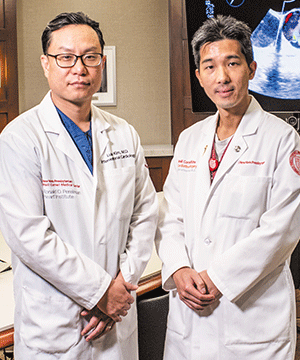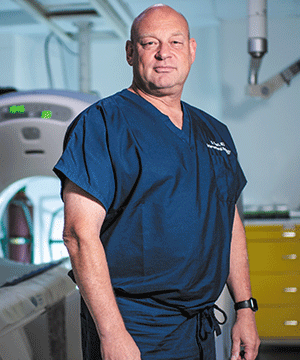Hybrid Heart Team: A Model of Collaboration

Dr. Luke K. Kim and Dr. Christopher Lau
Close collaboration of interventional cardiologists and interventional radiologists with cardiac surgeons continues to play an invaluable role in the treatment of cardiovascular diseases. Catheter-based technologies along with the public’s enthusiasm for minimally invasive approaches have made the hybrid heart team concept an attractive approach for physicians and patients alike.
“We have a large aortic surgery program with a high volume of open surgery, but we have many patients who are best suited for endovascular interventions,” says Christopher Lau, MD, cardiothoracic surgeon at NewYork-Presbyterian/ Weill Cornell Medical Center. “We often work with the interventional cardiologists or interventional radiologists who are experienced with imaging techniques, wire and catheter manipulation, and percutaneous access techniques. At any given time, we work with several teams to cover all the bases for what is necessary for successful endovascular aortic interventions. By having several experts with specific skill sets thinking about the treatment instead of just one person, it helps us provide the optimal treatment, which translates into less operative time, less anesthesia, and a quicker recovery for our patients.”
“We plan and perform the endovascular treatment of aneurysms and dissections together as a team, rather than as individuals,” says Luke K. Kim, MD, an interventional cardiologist at Weill Cornell. “We have created a heart team comprised of a cardiothoracic surgeon, an interventional cardiologist, an anesthesiologist, and an image-focused cardiologist to provide the best care tailored to different clinical scenarios.”
“Our collaborations began with transaortic valvular cases and have taken off,” continues Dr. Kim. “We have a large population with challenging connective tissue disorders, such as Marfan syndrome. These patients have poor outcomes if the procedures are done suboptimally. It’s been great working with Chris as he has experiences surgically that add immeasurably to my experiences with catheter-based procedures that we both appreciate and find useful.” Outside of the OR, Dr. Lau and Weill Cornell interventional radiologists have pooled their expertise in the development of the AngioVac System, an endovascular suction device for removing large intravascular thrombi and emboli.

Dr. David W. Trost
Throughout his career, David W. Trost, MD, former Director of Interventional Radiology at Weill Cornell, has witnessed a natural evolution in the endovascular world. He now often collaborates with Dr. Lau on thoracic aortic aneurysm repairs.
“When I started in the 1990s, our stent grafts were completely homemade,” he says. “We would sit and sew graft material and put metal stents inside of it. We would then have to have it sterilized and compress it down into a delivery system in the operating room. Today, we have advanced imaging, state-of-the-art equipment, refined techniques, and greater knowledge, which allow us to treat conditions that we could not begin to dream of treating in a minimally invasivIn reflecting on Weill Cornell’s heart team approach, Dr. Trost gives high marks not only to the surgeons and anesthesiologists, but also to excellent postoperative management. “Before Dr Lau, I performed the endovascular procedures with Dr. Leonard Girardi, Chairman of Cardiothoracic Surgery and a world expert in the surgical repair of aortic aneurysms,” says Dr. Trost. “Dr. Girardi and his team have a phenomenal post-procedure recovery system in the cardiac ICU. The operation is just the beginning of the treatment process. The care after the operation is just as important to ensure optimal outcomes.”e manner 20 years ago.”



